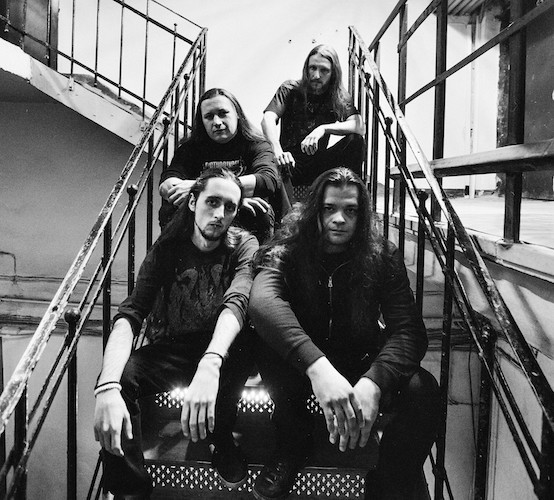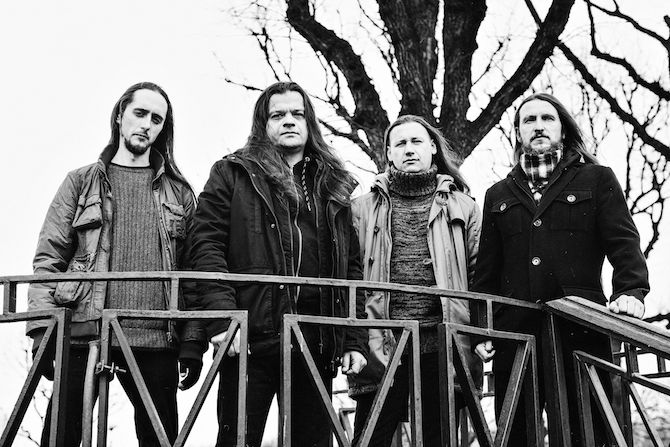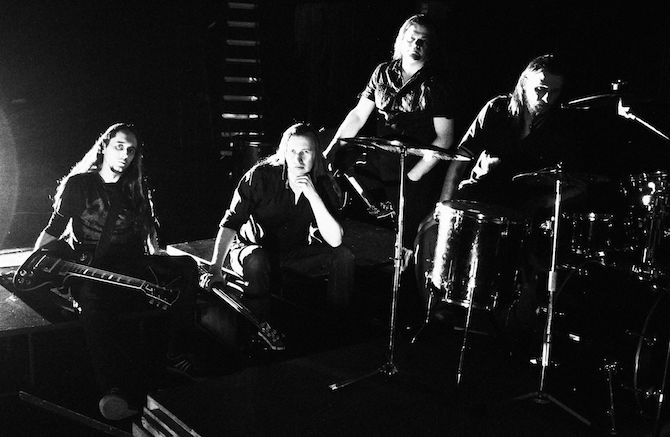(Comrade Aleks brings us this interview of Vitaly Larv, guitarist/vocalist of the Russian band Psilocybe Larvae, who released a new single just last week.)
Psilocybe Larvae was born in the Russian underground about 22 years ago. Mixing black and death/doom metal, they came through their searches to an extreme progressive mix which is hard to define sometimes, but the band tagged it “manic depressive metal”. Their fourth album Labyrinth Of Penumbra was released in 2012, the band’s line-up changed, and who knows what happened during the period since then!
However, Psilocybe Larvae have returned with a new single, “The Fall Of Icarus“, so it’s time to remind our readers about the band and try to sort out what’s been going on. The band’s founder Vitaly Larv (guitars, vocals) takes the floor.
Hello Vitaly! Psilocybe Larvae was born in 1996, but your first official release saw the light of day in 2000. How did you spend those first years?
Hi! It was so long, dude. I don’t even remember. Certainly, we were doing all the things that a new young band does – sex, drugs and rock’n’roll 🙂
Actually we had enough material to make two albums before the first official record at least, but we just had no money, good equipment, or a label’s backing to release it. After a few months of rehearsals a demo “Liar“, was recorded and with this stuff we started playing gigs.
We managed to enter a professional studio only in 1997, where we recorded a song for the “Russian Alternative Extreme Music” compilation. It was a great experience, so we firmly resolved to record the full-length album. That’s how Stigmata was born.
The band was named after a pretty obscure line taken from Tiamat’s song “Whatever That Hurts”, but your full-length album Stigmata is closer to a melodic black metal sound. What built your sound back then?
There was a black metal era and we surely were influenced by bands like Emperor, Satyricon. So that’s why the album has some blackish touches. We were just acting on a hunch. Generally it’s a matter of arrangement because the majority of music was written on an acoustic guitar.
How often did you play gigs in those years? Were people more enthusiastic towards gigs of local bands back then than nowadays?
We played pretty often and packed a big crowd in. What to say… metal was very popular in those times. There wasn’t internet and people spent their time in clubs, hanging out and listening to the music. Big bands came not so often, so we were being small local stars 🙂
The next album Agony was released in 2003. Can you tell us what Psilocybe Larvae formed as its style on that album? What were the main components of your manic depressive metal?
We added some progressive elements while keeping the doom and black metal parts of the music. It became an eclectic but more dark and depressive album where we in general continued to evolve what we had created in Stigmata. I think Agony sums up what we wanted to do in this genre.
From where did the doom element of Agony come? And how did you build a connection between the doom and black aspects in your songs? Was it technically difficult to switch from one to another and back?
It came naturally because we listened to a lot of doom and black metal at that time. It exactly matched our mood and behavior too. So it couldn’t but be reflected in our music. As to technical aspects, it’s not so difficult if you have basic skills in playing instruments.
What did you want to transfer through your lyrics? Is it an important part of Psilocybe Larvae’s creative essence?
Sure, lyrics are bound up with music and emphasize an atmosphere which the music sets. I’m trying to transfer my emotional experience, my thoughts about purpose in life, death, madness. It’s a struggle with my personal demons, I think 🙂
There was an almost five-year long break between Agony and Non-Existence; what slowed you down?
Agony was the final chapter for Psilocybe Larvae‘s history in our home town Vyborg. Due to different reasons the band relocated to St. Petersburg and underwent some line-up changes. It took quite a lot of time to complete the line-up and continue active work on a new album. We messed with the album over a long time and then searching for the proper label. As you can see, there were a lot of reasons. Besides, I’m very self-critical when it comes to songwriting and we spent a lot of time doing arrangements on all the songs until the result satisfied us. So it’s better to have one powerful album than a bunch of so-so ones. This also applied to our next release. There was a five-year interval between Non-Existence and The Labyrinth Of Penumbra. We are fucking lazy asses 🙂
Then I don’t doubt that you were ultimately satisfied with Non-Existence in the end, but can you name – from your point of view – the stronger sides of the album?
Non-existence is a huge step up from our previous albums. We grew up, and so did our music too. So it is a more diverse album. Besides doom and black elements, it contains also death metal and progressive parts, more keyboard parts with massive guitar riffs. For fans of technical progressive melodic death metal, it’s recommended!
How did you work over these songs in the studio? Did you meet any obstacles recording the album?
Nothing special. We began the recording process with all the songs written and fully rehearsed. Entering the studio, we had an understanding on what the album should sound like, because there is no time to do experiments there. I think the main obstacle as for any other band is the lack of money 🙂
And equipment? I guess that DDT Studio should be pretty well equipped.
Yes, this is a good studio made by the DDT band (a very famous rock band in Russia) for their personal goals, but sometimes other bands book it for recordings too. You know there are many well-equipped studios, but the main thing is who runs the process of making the album. This time we managed to work with great sound engineers like Yura Smirnov at DDT Records, Slavik & Wojtek Wieslawski in Poland (Studio Hertz), and Thomas Eberger in Sweden (Cutting Room). So we couldn’t be more pleased with how it turned out.
Psilocybe Larvae’s fourth album The Labyrinth Of Penumbra saw the light of day in 2012 — what kind of concept (in the wider sense) did you have for this album?
Basically we wanted to have this album be cohesive, which would combine all the kinds of genres we have ever done musically, while adding new musical directions. The songs are all linked to each other by the lyrics and by the feeling in the music.
The main concept of the album revolves around the labyrinth of penumbra, the world created by our phobias, superstitions, pain, fear and nightmares – the labyrinth of the human mind. It’s like a dream or a program created by the Penumbra creatures. Only in sleep you can walk through their labyrinth and try to crack the program and free your mind and soul. Philosophically speaking, this is the path you have to go through to find enlightenment and finally reach realization, to see your shambhala. This is the way of pain, sacrifice, decease, oblivion and reincarnation.
This material is the most professional, tight, and progressive work that Psilocybe Larvae ever recorded. How would you compare The Labyrinth Of Penumbra with Stigmata? What are the principle differences between these two works?
I think you have already answered the question. The Labyrinth Of Penumbra is a more professional and progressive work where the music, lyrics, and artwork are tied between themselves.
Stigmata is our first album, and it’s a bit of a naïve one, but it bribes with its atmosphere and catchy melodies. By the way, people make these albums stand out from our discography — some think Stigmata is the best and others call The Labyrinth Of Penumbra a masterpiece.
The Labyrinth Of Penumbra was mastered by the famous Mats Lindfors (R.I.P.). How did you get in touch with him? Did you choose him or was it an idea of your label?
He worked at the Swedish mastering studio Cutting Room where we mastered our previous album Non-existence. So we were very excited when they offered us Mats as a mastering engineer for The Labyrinth Of Penumbra. It’s an honor to have such a great professional who worked with many big stars like Scorpions, Roxette, Meshuggah. It’s very sad he passed away too early. R.I.P.
How do you see the band’s place on the Russian extreme metal scene nowadays?
This kind of music isn’t popular here, therefore I think we are out of the Russian metal scene and out of time 🙂
What about new stuff? Do you already have a plan for a next album?
We’ve been working on new songs for almost a few years. The foundation for the recording is laid, we just need to do some adjustments on the songs to make it sound better and play them at the gigs just to feel them better as a band. Of course there is no intention to drag this out, given the fact that it’s been 6 years since the release of our latest album The Labyrinth Of Penumbra, but there are too many factors affecting this process – time, money, line-up changes (again) and so on…
But we’ve got good news, the new promo single “The Fall Of Icarus” has recently been released just in order to give listeners a taste of what to expect from the next album.
Check it out on our official Bandcamp.
How does the new material differ from things you’ve done before with the band?
It goes in the same direction set by the previous album, but it drives more into a rock style. The material is more simple and easy to digest, but still keeps our dark atmosphere and heavy sound. These songs really do stand out and I hope that the new record will be a huge step forward for the band.
What’s Psilocybe Larvae ultimate message? What’s it all about?
Thank you for paying attention to our band and don’t forget to visit our webs:
http://psilocybe-larvae.ru
http://www.facebook.com/psilocybelarvae
https://psilocybelarvae.bandcamp.com
Stay positive, listen to good music. Peace to you all!



